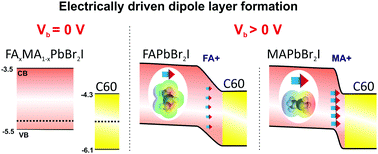Dipolar cation accumulation at the interfaces of perovskite light-emitting solar cells†
Abstract
Ionic migration plays an important role in the operation of perovskite-based solar cells and light-emitting diodes. Although ionic migration is a reversible process, it often leads to worsening of the perovskite-based device performance and hysteresis in current–voltage characteristics; the phase segregation in mixed halide perovskites is the most harmful effect. The reason lies in the dynamical band structure changes, one of the biggest challenges in the development of light-emitting solar cells, which can be solved through controllable engineering. Herein, we demonstrate the controllable band structure bending due to ion migration under an applied voltage in mixed halide perovskite devices. The band structure rearrangement is demonstrated in light-emitting solar cells based on the perovskite with organic cations methylammonium (MA+) and formamidinium (FA+), and with PEDOT:PSS and C60 transport layers having a high barrier of 0.8 eV for charge injection. The devices based on MAPbBr2I and FAPbBr2I demonstrate different threshold voltages of 1.7 and 2.6 V, respectively, in the LED regime after device pre-biasing, whereas the device with the monohalide perovskite MAPbBr3 does not demonstrate such behavior. We assume that this arises from the different dipole moments of the organic cation molecules, MA+ and FA+, possessing non-zero dipole moments of 2.29 Debye and 0.21 Debye, respectively. Our hypothesis is that under the applied voltage, perovskite cations and anions move towards the perovskite/transport layer interfaces and form accumulation layers. Moreover, the organic accumulation layer at the perovskite/electron transport layer interface additionally bends the device band structure and lowers the LED threshold voltage due to its dipole nature. This ability to change the device band structure in situ opens the way for the development of dual functional devices based on a simple design. In addition, it makes the mixed halide perovskite more flexible than monohalide ones for the creation of different optoelectronic devices without the use of special types of transport materials.



 Please wait while we load your content...
Please wait while we load your content...